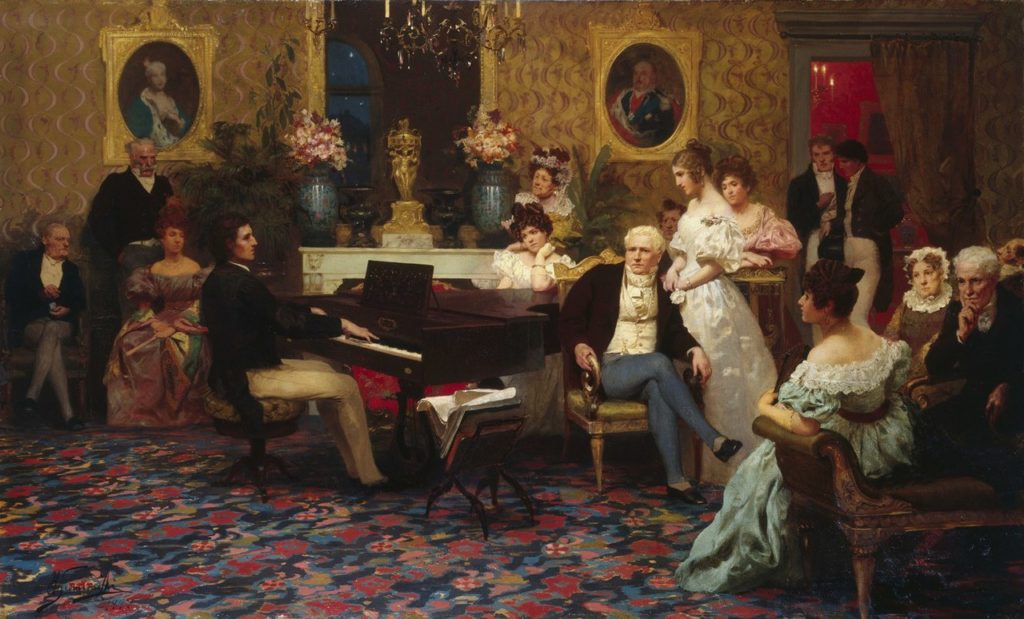Table of Contents
Introduction
In this article, I would like to talk to you most practically and concisely possible about the figure of Fredéric Chopin, a composer who profoundly contributed to the birth and development of contemporary pianism. I would like to spare you all those encyclopedic notions that you could find everywhere and offer you some original considerations about his biography and style. He tried to overcome the limits hitherto associated with the piano by emerging from the romantic current as a revolutionary composer: never before Chopin had anyone paid so much attention to this instrument, never had anyone explored its characteristics and limits with such deep dedication. It is only among his contemporaries that we can find composers that deserve equal attention, also due to technical reasons to be attributed to the development of keyboard instruments technology. But Chopin does not come from nowhere: he too is a son of his time, despite his uniqueness. As we have already seen in many previous articles, during the eighteenth century and throughout the nineteenth century a radical shift of the musical axis from the vocal to the instrumental conception was being prepared. Precursors of this transition will be composers such as Girolamo Frescobaldi, about whom we talked about in a previous article that you can find here.

Fredéric Chopin And Romanticism
Fredéric Chopin lived in full Romanticism: in fact, we have already seen in previous articles that the romantic current took root in the eighteenth century and developed to its maximum expression only in the nineteenth century. We talked about this in a previous article that you can find here. Although the chronological limits of Romanticism are very often precisely outlined by the manuals of History of Music, these limits are rather arbitrary: think for example of all the great composers who used eighteenth-century styles, such as the motif-thematic elaboration, to write a romantic composition in the twentieth century, when Romanticism was already over. Or, making the same example, but reversed, to those composers of the eighteenth century that we count today among the proto-romantics: an example above all is František Xaver Dušek, then we could cite Carl Philipp Emmanuel Bach.
Childhood
It is often said that Chopin was in very poor health. Instead, a fact that is not often remembered enough is that as a child he was brought by his parents to the countryside to recover. This detail tells us something fundamental about the first sources of musical inspiration of the Polish composer: in the countryside, Chopin had the opportunity to get in touch with the popular heritage of Poland, listening to peasant songs and absorbing the sounds largely related to the use of dialect. Of course, he could not have absorbed the results of such a legacy if he had not had rigorous musical training, very open even if it initially took place within the home. His first teachers were his mother and his sister, but soon they recognized, as had happened to one of Paganini’s first Masters, that they had nothing more to teach him: at that point, Chopin was sent very early to learn from a Master.
Adolescence
His first compositions came at a very early age, at the age of seven he gave his first public concert and composed his first Polonaise . He finished his musical training at about twenty-nine, and soon after, at about thirty, he moved to Vienna: here he learned that Poland had opposed the occupation of the Russians. The news shocked him: immediately after, perhaps also because of the new prejudices of the Viennese against the Poles, we have news of his transfer to Paris. Chopin made a great effort to adjust to the city, as he was leading a profoundly different life from what he had been accustomed to until then. In particular, the Parisian bourgeois and aristocrats loved worldly life, which consisted of gathering in the drawing rooms of the most fashionable palaces. However, he managed to handle it, especially thanks to the private lessons he gave to young people of high economic extraction.

Maturity
The last years of the Polish composer’s life were very difficult: he was seriously ill, and was assisted for some time by some of his favorite students who convinced him to move to England. The English climate was not good for his illness: back in Paris, he died at the age of thirty-nine. At the end of his days, fearing that he might be buried while still alive, Chopin wrote the following:
When this earth suffocates me, I beg you to open my body so that it is not buried alive.
Fredéric Chopin
For this reason, the heart of the Polish composer is now an heirloom preserved in an urn of the Church of the Holy Cross in Warsaw.
The Style
As you have probably already heard in numerous other sources, Chopin’s musical style was characterized by a unique elegance in the use of colours and harmonic solutions outlined on a poignant lyricism, by a melodic line often conceived on operatic themes with intense lyricism or belonging to the popular tradition. Let’s see below some examples, among the best known, of compositional styles used by the Polish composer.
The Polonaise
The Polonaise is popularly considered, wrongly, an exclusive of Chopin. In reality, this style is due to the homonymous dance, known since the sixteenth century and which, like most of the dances handed down until the eighteenth century, was turning into an instrumental piece. Chopin’s Poles go a step further and become an instrument that expresses the heroic and military trend typical of Polish musical culture. Chopin looked at his cultural heritage with nostalgic eyes, since Poland was now occupied by Russian enemies precisely in the period of the most relevant compositions written in this style: think for example of the Polonaise in E flat minor opus 26 number 2 composed in 1835 or the Great Polonaise Brilliant opus 22 composed in 1830 through the disillusioned eyes of those who see his land fallen into the network of invaders. Below you can find one of the most famous Polonaises written by the composer; it is followed by a link where you can order the full score of the Polonaise written by Chopin, in the edition that I suggest (in my opinion, the best): if you do it from the banner below, a small percentage of your purchase will go to support this blog.
The Mazurka
We talked about mazurkas in a special article that you can find here, so we will not dwell on this compositional style: you just need to know that that of mazurka is probably the style in which Chopin has poured more popular legacies collected in the Polish countryside.
The Nocturne
Parenthesis apart deserve Nocturnes, inspired by John Field who was (and still is) considered the inventor of this style. Chopin writes that Field’s first nocturne is the father of all nocturnes, including his own. This compositional form was originally a composition in which a melody studded with blooms moved, with lyrical making and a pronounced lyricism. Usually this melody was accompanied, at the bottom or at the top, by a harmonization. Since in this blog we also deal with Musical Analysis, and therefore necessarily composition, it will not be superfluous to indicate that to compose a nocturne it is sufficient to invent a theme of four bars and repeat it along the composition always giving it new ornamentations. this repetition must move in the following scheme:
| A1 |
| B |
| A2 |
| B |
| A3 |
| Tail |
Of course, this compositional process is easier to analyze in broad terms than to compose in detail: it was almost always enriched by a multiplicity of procedures much more complex than those described, the repetitions of the theme for example are always dotted with complex transitions that stood between one repetition and another as short-term modulations. In the style of the Nocturne, more than in others, the influence of Italian singing in Chopin is evident: he loved this way of creating music, so much so that he advised his students for a long time to adapt the songs of the soprano, Giuditta Pasta, to the piano. Below you can find a performance taken from YouTube, followed by a link where to order the full score of the nocturnes written by Chopin, in the edition that I suggest (in my opinion, the best): if you do it from the banner below, a small percentage of your purchase will go to support this blog.
Conclusions
For this article on Fredéric Chopin is everything, do not forget to subscribe to our email form so as not to miss the news on this author: we will certainly have the opportunity to explore in detail his scores in the section reserved for Musical Analysis. See you in tomorrow’s article!
- History Of The Piano – The Fortepiano - July 12, 2022
- Curt Sachs – History Of Organology At a Glance - July 8, 2022
- Giuseppe Verdi – Rigoletto, Il Trovatore, La Traviata - June 29, 2022
